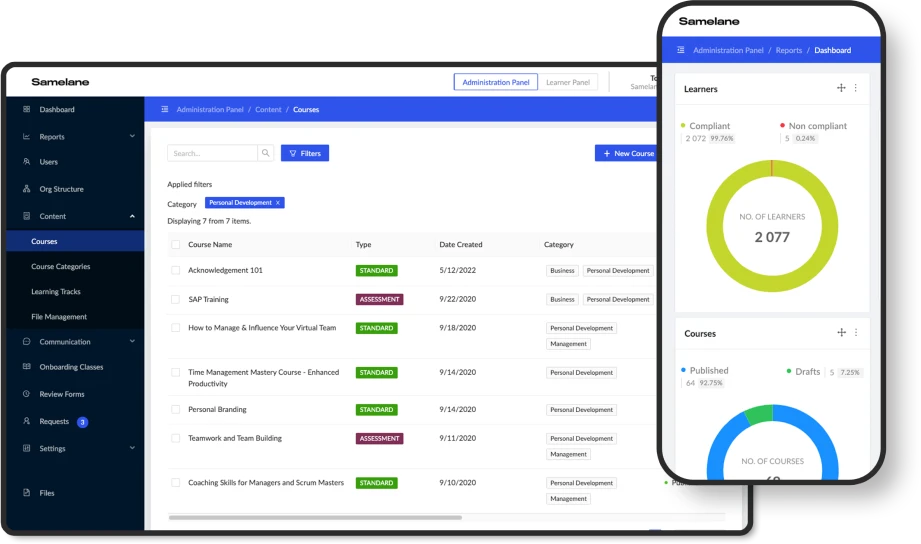When choosing a remote learning platform (LMS), companies very often focus on its basic functionalities and its capability to import existing courses, create new training courses, and manage the entire training process. Nevertheless, the data collected by an LMS and the business value within are also important. How do LMS reports help optimize training processes?
This article will explain the following:
1) What is advanced analytics in an LMS?
2) What are the key reporting functions of an LMS?
3) How do automatically generated reports work?
The benefits of using Learning Management Systems (LMS)
E-learning platforms (LMS) are modern solutions with a number of tangible benefits, both for the company and its employees. From the business point of view, introducing a Learning Management System is an investment, and therefore it should provide a satisfactory rate of return. What can be expected from investing in the best LMS platforms available on the market?
The ability to convert costly and time-consuming classroom training courses into e-learning courses is undoubtedly a measurable benefit; they are no less engaging, equally interactive and, more importantly, scalable. This is especially important for large organizations which operate in several locations and time zones. In such companies, the costs of onboarding employees and implementing training policies are usually very high and the processes are time-consuming. A modern e-learning platform saves time and money, and additionally allows employees to improve their competences at any time, from any place and using any device.
Moreover, the algorithms of a Learning Management Systems allow companies to significantly automate the implementation of training strategies. It is possible to create rules on the basis of which individual employees are assigned training, e.g. onboarding courses, which every new employee should undergo, or mandatory courses such as health and safety. An LMS will not only assign such courses to individual people, but also remind them about deadlines, and thus relieve HR departments of many responsibilities.
Statistics show that only 13% of the organization’s employees are involved.
State of the Global Workplace, Gallup
Nowadays, offering wide opportunities to raise competences and democratizing access to training materials isn’t perceived as an additional benefit, but as a standard expected by employees. For many of them, poor training quality or lack thereof is one of the main reasons for quitting their jobs. Investing in a remote learning platform allows companies to increase the level of employee involvement, reduce the turnover rate, and build the image of desired employer.

What is LMS reporting?
One of the functions of Learning Management Systems which are extremely important from a business point of view is the ability to generate various reports. They concern not so much the courses themselves, but most of all the behavior of platform users. Thanks to real-time reports, the progress made by employees, entire teams or lines of business can be easily tracked.
Through the daily use of an LMS, each user generates a lot of important information. A modern LMS allows management to monitor the data: it can track course progress; verify whether a particular user has completed the training; inspect test results, test-writing time and number of approaches; check which parts of a test or course were more demanding, or which of them caused a participant to drop out.
Knowing which elements of a course take the most time, which cause participants to quit, and which parts of tests are the most difficult allows companies to take appropriate remedial steps. Courses can be improved, supplemented with additional materials or interactive elements, and the method of presenting particular issues can be changed or illustrated with better examples. All training programs require constant monitoring and user feedback analysis; without continuous improvement and updating, they will not bring the expected results.
Reporting & analytics features
When deciding to choose the optimal LMS platform for your organization, it is worth paying attention to its reporting and analytics capabilities. It is important that these possibilities are as wide as possible and that the time of generating reports is kept to a minimum. The best LMSs on the market, including Samelane, are equipped with artificial intelligence, which makes the processes of reporting, analyzing data and drawing conclusions extremely simple and fast.
What functionalities of reporting and analytics are worth paying attention to? The following features are noteworthy:
- tracking progress and course completion rates;
- monitoring the popularity of courses and the level of student involvement;
- analyzing the results of tests and surveys;
- tracking key statistics of individual training courses (e.g. popularity);
- monitoring the time spent on individual courses / modules;
- analyzing student feedback and grades;
- checking the number and type of certificates obtained by the students.
The benefits of LMS reporting and analytics
Broad reporting possibilities are one thing, but using the available data, analyzing it correctly, and taking specific actions based on the analysis is another. What conclusions can be drawn from analyzing the data collected by an LMS system? How does data analysis help improve the training process and increase its efficiency?
The first important argument in favor of analyzing data from an LMS platform is the continuous improvement of training materials. If the time to complete a specific training / module is shorter than the actual time devoted to it by the students, it may mean that the content is difficult to understand or inadequately presented. It will probably be necessary to supplement it or prepare it again from scratch. If the statistics show that most employees use smartphones while learning, taking this into account when designing courses and optimizing them for mobile devices might be worthwhile.
If a training session is stopped by many users shortly after it has started, and the completion rate remains very low, this may also indicate an issue that needs to be addressed. Most likely, in the opinion of the trainees, the course does not bring the expected values and is not worth their time. It also happens that compulsory and repetitive training courses are “clicked through” by the students. This is shown by extremely short completion time. In such situations, adding interactive elements or follow-up questions might be a solution, because they will force the participants to read the material more carefully, and therefore reach the course’s goal.
By analyzing data from an LMS, the level of student involvement can also be carefully monitored. In order to achieve the training goals, it is extremely important for the trainees to interact with the educational materials, use all available opportunities and actively participate in the training sessions, e.g. leave comments, share their own experiences, or answer open-ended questions. When analyzing the obtained results, wider context should be taken into account. It may turn out that low commitment simply results from lack of time, which may be characteristic of specific teams (e.g. operating in an environment of frequent deadlines) or typical of a specific period of the year (e.g. holiday season).
Reports automatically generated by an LMS and a clear dashboard presenting key metrics to people responsible for implementing training policies can undoubtedly contribute to a significant improvement in the efficiency of operations and the level of employee satisfaction.










